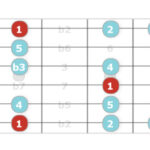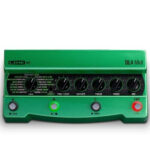The A Minor Pentatonic Guitar Scale is a foundational scale for guitarists across genres, from blues and rock to pop and beyond. Its simplicity and versatility make it a must-learn for anyone wanting to improvise, write riffs, or understand the building blocks of countless songs. This guide will break down everything you need to know about the A minor pentatonic scale, including its shapes, positions on the fretboard, and practical ways to use it in your playing.
What is the A Minor Pentatonic Scale?
The term “pentatonic” comes from the Greek word “pente,” meaning five, indicating that this scale is composed of five notes. The A minor pentatonic scale, specifically, is a minor scale with the 2nd and 6th degrees of the natural minor scale omitted. This results in a scale that is easier to play and inherently bluesy and melodic.
The notes in the A minor pentatonic scale are:
A – C – D – E – G
These notes correspond to the following intervals from the root (A):
- Root (1): A
- Minor Third (b3): C
- Perfect Fourth (4): D
- Perfect Fifth (5): E
- Minor Seventh (b7): G
This interval pattern – minor third, perfect fourth, perfect fifth, minor seventh – is crucial for understanding the scale’s construction and how it relates to chords and other scales.
The A minor pentatonic scale is closely related to the C major pentatonic scale. In fact, they share the exact same notes, but the root note is different. A minor pentatonic is considered the relative minor of C major pentatonic.
Visualizing the A Minor Pentatonic Scale on the Guitar Fretboard
Understanding the shapes and positions of the A minor pentatonic scale on the guitar fretboard is key to unlocking its potential. There are five primary shapes that connect to cover the entire neck of the guitar. Learning these shapes allows for fluid movement and improvisation across the fretboard.
Two-Octave Pattern
Here’s a diagram showing the A minor pentatonic scale in a two-octave pattern. The darker notes indicate the root note (A). This pattern starts with the root note on the 5th fret of the 6th string.
## A Pentatonic Minor 2 octaves
Full Fretboard Diagram
To truly master the scale, it’s beneficial to see it across the entire fretboard. This diagram illustrates all the notes of the A minor pentatonic scale across the guitar neck.
## A Pentatonic Minor full fretboard
Alt text: A Minor Pentatonic Scale diagram showing all positions across the entire guitar fretboard, highlighting root notes.
Shape 1 (5th Position)
Shape 1 is often the first shape guitarists learn. It’s located in the 5th position (starting around the 5th fret) and is very common for playing in the key of A minor.
## Shape 1 (5th position) with fingerings
Alt text: A Minor Pentatonic Scale Shape 1 diagram in the 5th position, showing suggested fingerings for guitar.
Shape 2 (7th Position)
Shape 2 connects to Shape 1 and moves up the neck to the 7th position.
## Shape 2 (7th position) with fingeringsShape 3 (9th Position)
Shape 3 is located in the 9th position and continues the pattern up the fretboard.
## Shape 3 (9th position) with fingerings
Alt text: A Minor Pentatonic Scale Shape 3 diagram in the 9th position, illustrating finger positions for guitarists.
Shape 4 (12th Position)
Shape 4 resides in the 12th position. Notice how the shapes start to repeat as you move higher up the neck.
## Shape 4 (12th position) with fingeringsShape 5 (2nd Position)
Shape 5 is found in the 2nd position. This shape connects back to Shape 1, allowing you to cycle through all five shapes seamlessly.
## Shape 5 (2nd position) with fingerings
Alt text: A Minor Pentatonic Scale Shape 5 diagram in the 2nd position on the guitar neck, showing finger placements.
Open Position
While less structured into a “shape,” the open position also utilizes notes from the A minor pentatonic scale and is useful for incorporating open strings into your playing.
## Open positionUnderstanding the Notes and Intervals
To solidify your understanding, let’s look at the specific notes and intervals within the A minor pentatonic scale.
## A Pentatonic Minor with note names
As previously mentioned, the notes are A, C, D, E, and G. The intervals from the root (A) are:
| Formula | Notes |
|---|---|
| 1 | A |
| b3 | C |
| 4 | D |
| 5 | E |
| b7 | G |
The intervals between consecutive notes in the scale are:
Root to minor third (A to C): minor 3rd (3 semitones)
Minor third to perfect fourth (C to D): major 2nd (2 semitones)
Perfect fourth to perfect fifth (D to E): major 2nd (2 semitones)
Perfect fifth to minor seventh (E to G): minor 3rd (3 semitones)
Minor seventh back to root (G to A): major 2nd (2 semitones)
This can be represented as the interval formula: 3 – 2 – 2 – 3 – 2 (semitones).
We can also express these intervals relative to the root note:
| Notes (ascending) | Interval |
|---|---|
| A-C | minor 3rd (m3) |
| A-D | Perfect 4th (P4) |
| A-E | Perfect 5th (P5) |
| A-G | minor 7th (m7) |
And descending:
| Notes (descending) | Interval |
|---|---|
| A-G | Major 2nd (M2) |
| A-E | Perfect 4th (P4) |
| A-D | Perfect 5th (P5) |
| A-C | Major 6th (M6) |
How to Use the A Minor Pentatonic Scale
The A minor pentatonic scale is incredibly versatile and used in a wide array of musical styles. Here are some common applications:
-
Blues and Rock Solos: This scale is a cornerstone of blues and rock guitar soloing. Its inherent bluesy sound makes it perfect for improvising over minor blues progressions and rock riffs. Think of guitar legends like Jimi Hendrix, Eric Clapton, and B.B. King – they all heavily utilized the minor pentatonic scale.
-
Riff Writing: Beyond soloing, the A minor pentatonic scale is excellent for crafting catchy riffs. Its simple structure and melodic nature make it easy to create memorable guitar lines.
-
Improvisation: Once you know the shapes, you can begin to improvise over backing tracks in A minor or related keys. Experiment with different rhythms, phrasing, and bending techniques to create your own unique solos.
-
Understanding Harmony: Learning the A minor pentatonic scale helps you understand the relationship between scales and chords. It connects directly to common chords used in minor keys.
Chords that Work with the A Minor Pentatonic Scale
Several chords harmonize well with the A minor pentatonic scale, making it easy to create backing tracks or understand chord-scale relationships. Some of the most common chords include:
- Am (A minor): The root chord, naturally.
- C Major: The relative major of A minor.
- Dm (D minor) or Dm7 (D minor 7th): The IV chord in A minor.
- Em (E minor) or Em7 (E minor 7th): The V chord in A minor.
- G Major (G5): The bVII chord in A minor.
While these chords generally work well, note that chords like Dm7 and Em7 contain notes (F and B respectively) that are not directly in the A minor pentatonic scale. However, the overall tonality still fits, and these chords are frequently used in conjunction with the scale.
A Minor Pentatonic Add2
For a slightly different flavor, you can explore the A minor pentatonic add2 scale. This scale adds the major second (2nd degree) to the standard pentatonic scale.
| Formula | Notes | Intervals | Degrees |
|---|---|---|---|
| 1 | A | Unison | Tonic |
| 2 | B | Major second | Supertonic |
| b3 | C | Minor third | Mediant |
| 4 | D | Perfect fourth | Subdominant |
| 5 | E | Perfect fifth | Dominant |
| b7 | G | Minor seventh | Subtonic |
The A minor pentatonic add2 scale contains the same notes as the A minor scale, except it omits the major 6th interval. This creates a slightly brighter sound compared to the standard minor pentatonic.
Practice and Exercises
To truly internalize the A minor pentatonic scale, consistent practice is essential.
- Play through each shape: Practice each of the five shapes ascending and descending. Focus on smooth transitions between notes and shapes.
- Use backing tracks: Improvise over A minor backing tracks or blues progressions. Start slowly and gradually increase your speed as you become more comfortable.
- Create riffs and melodies: Use the scale to write your own riffs and short melodic phrases. This will help you apply the scale creatively.
- Explore different rhythms: Practice playing the scale with various rhythms, including triplets, sixteenth notes, and swing rhythms.
Normal tempo: Slow tempo:Listen to the audio examples to hear the A minor pentatonic scale in action.
A Pentatonic Minor scale first shape ascending.
Alt text: Guitar tablature for A Minor Pentatonic Scale Shape 1 ascending, showing finger numbers.
For further practice, consider exercises that focus on specific techniques and patterns within the scale.
Scale shapes with triplet pattern (tab & standard notation)
This scale is also a key component of blues guitar playing, as covered in resources like the “Blues soloing series,” specifically “Blues lead guitar – lesson 6.”
Conclusion
The A minor pentatonic guitar scale is an indispensable tool for any guitarist. By learning its shapes, understanding its construction, and practicing its application, you’ll unlock a world of musical possibilities for improvisation, songwriting, and understanding music theory. Start practicing the shapes today and begin your journey to mastering this essential scale!


